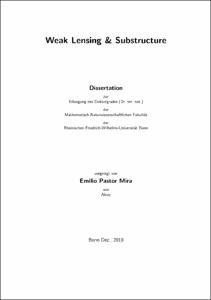Pastor Mira, Emilio: Weak Lensing & Substructure. - Bonn, 2011. - Dissertation, Rheinische Friedrich-Wilhelms-Universität Bonn.
Online-Ausgabe in bonndoc: https://nbn-resolving.org/urn:nbn:de:hbz:5N-25169
Online-Ausgabe in bonndoc: https://nbn-resolving.org/urn:nbn:de:hbz:5N-25169
@phdthesis{handle:20.500.11811/4976,
urn: https://nbn-resolving.org/urn:nbn:de:hbz:5N-25169,
author = {{Emilio Pastor Mira}},
title = {Weak Lensing & Substructure},
school = {Rheinische Friedrich-Wilhelms-Universität Bonn},
year = 2011,
month = may,
note = {Understanding the evolution of the dark matter halos of galaxies after they become part of a cluster is essential for understanding their own evolution.
This thesis is a feasibility study on applying galaxy-galaxy lensing to galaxies in clusters. The method requires large clusters samples, which will be available in the near future after the publication of this work.
Galaxy-galaxy lensing allows a non-parametric inference of the average mass distribution of a galaxy sample. We propose a method that separates the weak-lensing signal of the dark-matter halos of galaxies in clusters from the weak-lensing signal of the cluster's main halo.
Using toy cluster models as well as ray-tracing through N-body simulations of structure formation along with semi-analytic galaxy formation models, we test the method and assess its performance. We show that with the proposed method, one can recover the density profiles of the cluster galaxy halos in the range 30 - 300 kpc.
Using the method, we find that weak-lensing signal of cluster member galaxies in the Millennium Simulation is well described by a Navarro-Frenk-White (NFW) profile. In contrast, non-singular isothermal mass distribution (like PIEMD) model provide a poor fit. Furthermore, we do not find evidence for a sharp truncation of the galaxy halos in the range probed by our method. Instead, there is an observed overall decrease of the halo mass profile of cluster member galaxies with increasing time spent in the cluster. This trend, as well as the presence or absence of a truncation radius, should be detectable in future weak-lensing surveys like the Dark Energy Survey (DES) or the Large Synoptic Survey Telescope (LSST) survey. Such surveys should also allow one to infer the mass-luminosity relation of cluster galaxies with our method over two decades in mass.},
url = {https://hdl.handle.net/20.500.11811/4976}
}
urn: https://nbn-resolving.org/urn:nbn:de:hbz:5N-25169,
author = {{Emilio Pastor Mira}},
title = {Weak Lensing & Substructure},
school = {Rheinische Friedrich-Wilhelms-Universität Bonn},
year = 2011,
month = may,
note = {Understanding the evolution of the dark matter halos of galaxies after they become part of a cluster is essential for understanding their own evolution.
This thesis is a feasibility study on applying galaxy-galaxy lensing to galaxies in clusters. The method requires large clusters samples, which will be available in the near future after the publication of this work.
Galaxy-galaxy lensing allows a non-parametric inference of the average mass distribution of a galaxy sample. We propose a method that separates the weak-lensing signal of the dark-matter halos of galaxies in clusters from the weak-lensing signal of the cluster's main halo.
Using toy cluster models as well as ray-tracing through N-body simulations of structure formation along with semi-analytic galaxy formation models, we test the method and assess its performance. We show that with the proposed method, one can recover the density profiles of the cluster galaxy halos in the range 30 - 300 kpc.
Using the method, we find that weak-lensing signal of cluster member galaxies in the Millennium Simulation is well described by a Navarro-Frenk-White (NFW) profile. In contrast, non-singular isothermal mass distribution (like PIEMD) model provide a poor fit. Furthermore, we do not find evidence for a sharp truncation of the galaxy halos in the range probed by our method. Instead, there is an observed overall decrease of the halo mass profile of cluster member galaxies with increasing time spent in the cluster. This trend, as well as the presence or absence of a truncation radius, should be detectable in future weak-lensing surveys like the Dark Energy Survey (DES) or the Large Synoptic Survey Telescope (LSST) survey. Such surveys should also allow one to infer the mass-luminosity relation of cluster galaxies with our method over two decades in mass.},
url = {https://hdl.handle.net/20.500.11811/4976}
}






